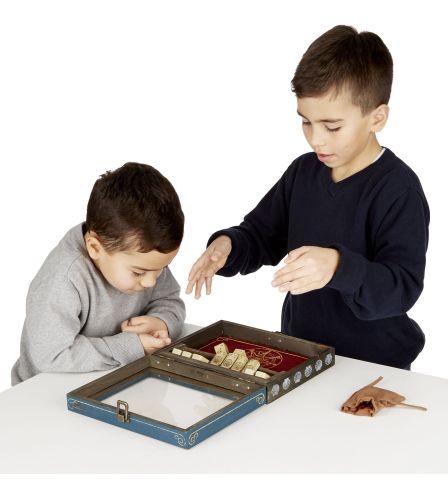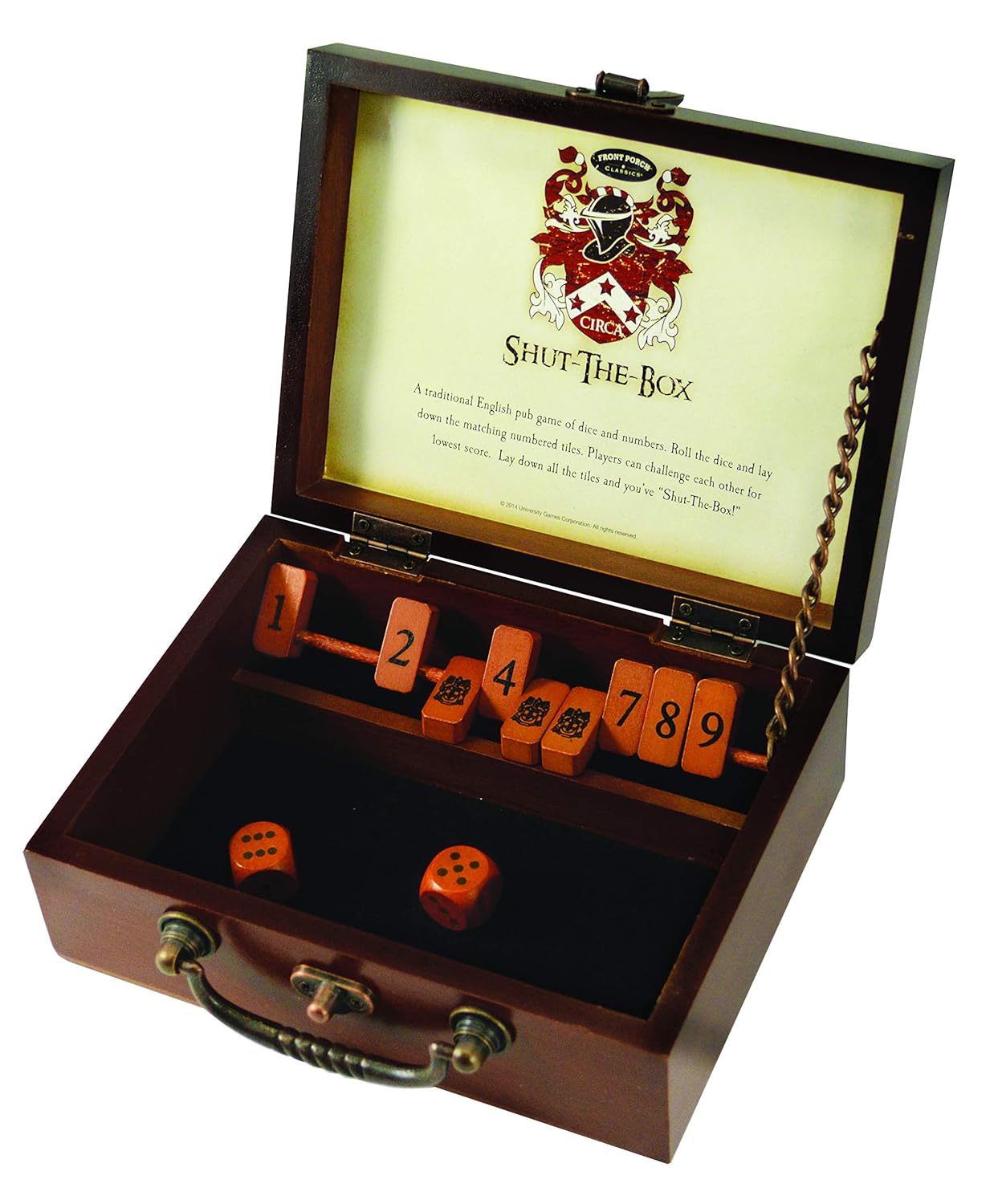The days are getting shorter and shorter and the weather is turning colder and colder, which can only mean one thing: you are running out of time to complete your holiday shopping. Especially if you have kids.
Not to mention, you may be struggling with the anxiety that all the kids’ toys are either too violent, too girly, too cross-marketed, too expensive or too useless.
Wouldn’t you feel virtuous if you could find a cool game that kids of all ages would love to play that would also be educational but not dorky? And wouldn’t it be even more super amazing if it would help your kids in math?
Have no fear! I am going to highlight two such games here. Yes, I use them in my educational therapy practice, so “It’s better than a worksheet” is a pretty low bar, but multiple parents have bought these games and played them on vacation with the whole family!
The first one is Shut the Box, traditionally a game sailors used to make out of a cigar box to play on long voyages. There are many versions available, from basic to fancy-dancy, and you can usually get it at any toy store.
The box that you are shutting has nine number tiles on hinges. They all start up and are folded down–shut–throughout the game. The first player rolls the dice and must shut a combination of numbers equal to the roll, using as few or as many numbers in any combination as they need. For example, if you roll 11, you can shut 9 and 2, 8 and 3, 7 and 4, or even 1, 2, 3 and 5. The same player continues until they roll a number they cannot make with the numbers still up. For instance, you roll a 5 and only have 2 and 9 still up. Their score is the total of all the tiles remaining. So in the previous example, they would score an 11. The point is to get the lowest score. If they get all the tiles down, they have shut the box! They get zero for that turn–the best outcome. And there is much rejoicing!
The math:
- Kids add up their rolls. Depending on their math level, this could mean counting all the dots, counting on or practicing math addition facts 1-6.
- For really young kids or kids with a severe math learning disability, just counting the numbers on the dice is great math practice. One fundamental math skill is subitizing, the ability to automatically recognize a number of objects or dots without having to count them. The skill is developmental, with little ones expected to be able to subitize up the three, and older ones being able to recognize numbers in predictable patterns, like on dice. Research has shown that when kids are weak at subitizing, they are very likely to have more severe math learning disabilities in school. Learning to quickly recognize which number you’ve rolled on dice is an excellent way to develop this ability. (If you are curious how your child is doing, check out this free screener
- Kids who have not memorized their math facts through 6 also get a lot of practice counting on, a practice parallel to finger counting. This skill has a developmental trajectory. Kids begin by counting both numbers starting at one. They move to counting on from one of the numbers, and then get to the most efficient level: counting on from the largest number.
- Kids who are starting to memorize math facts not only get a chance to practice the ones they already know, but to use mental math strategies to figure out the ones they don’t know. For instance, most math curricula start with memorizing doubles. But what if they roll 4 and 5, or 5 and 6? You can help them realize this is a “doubles plus one” situation: if they know 4 + 4 is 8, then what is 4 + 5? One more!
- Kids think flexibly about the best tiles to equal the roll.
- You rolled a 4 and a 5, that makes 9, but if the 9 is already down, then you could use 8 and 1, 7 and 2…There is some strategy in the choice, as it is best to get rid of the big numbers first, and very useful to have smaller numbers available to give you optimal flexibility, especially towards the end.
- Sometimes you need three or more tiles to make the number, which is another level of mental math practice.
- There is a cool pattern I lead kids to see: if you look at where their number is, then the row of numbers less than that, the partners to that number are the highest + lowest, second highest + second lowest on into the center–sort of like playing chopsticks on the piano. Since partners to ten is another super important and useful set of facts (1 + 9, 2 + 8, 3 + 7), this is a great visual for that–since 10 is off the board, the partners include the entire row.
- Kids add up the numbers remaining for their score.
- This is nice because there are often more than two numbers. I like doing a think-aloud to show kids any strategies I have used to add them up, like “Ah! I see a partner to ten here, and then I can add the two, so it is twelve.” I also ask them what their strategy was.
- Sneaky trick: I have them add up my scores too. If they protest, I say I’ll do it, but I might cheat…this usually serves as incentive enough to do a bit more math.
- Kids keep track of the total score.
- Once kids can handle double-digit addition, I put them in charge of keeping score. We tally it after every turn.
- Kids decide who has won and by how much.
- In fact, I ask this final question with all my students for any game with a score. It’s a great way to make the difference model of subtraction real and kids tend to naturally use counting up as a strategy.
The second game is more specifically designed as an educational game, but is equally fun and engaging. It is called Ten Frame Towers, by Junior Learning, and you can get it at most teacher supply stores and (of course) on Amazon.
The game consists of color-coded tens-frame representations of numbers 1-10 and two dice with tens-frame numbers on them. The goal of the game is to see who can build the biggest tower of tens. The first player rolls and takes one of each number on the dice. If the two numbers are partners to ten, then they get to make the first level of their tower. Otherwise, they save the pieces for when they can be combined to make a ten. The next player does the same, and play continues until all the pieces are used up. The player with the highest tower wins.
The math:
- Kids see, feel and experience each number. Remember when I mentioned subitizing above? Well, dice organize the numbers in one set of patterns that can become immediately recognizable, and tens frames organize them in another. Young kids or those with a math learning disability may need to count the holes to identify the numbers to begin with, but often then build up to recognizing 1, 2, 3 and 4 automatically, and can then start to see the bigger numbers as groups of those. I myself was surprised that I started to see the four square as the basis of each number–I would have thought it would be the line of 5.
- Kids focus on partners to ten. As I mentioned above, the partners to ten is a super useful set of facts to have memorized. A lot of mental math can be built on a robust understanding and automatic recognition of partners to ten.
- Partner-to-ten, ten-to-teen. This powerful mental math strategy involves taking two single-digit numbers that equal a number over ten, for instance 7 + 5, and making a ten by moving enough numbers from one to the other; then adding the left over to the 10–that’s the ten-to-teen part. For 7 + 5, you think: hmm, 7’s partner to 10 is 3, so I’ll take 3 from the 5 and add it to the 7; that makes 10 + 2; adding a number to ten is easy because it just makes the teen: 12.
- Advanced version: partner-to-ten, multiple-of-ten. Once kids become good at partner-to-ten, ten-to-teen, they can apply it to bigger numbers. Moving on from the above example, what if the kid sees 37 + 5? As long as they have the basic strategy down, and know that 40 is the next 10 above 30, they can figure it out: 37 + 5 = 40 + 2 = 42.
- Scouting for partners to ten in adding more than two numbers. Chances are if you still add up your checkbook by hand, you use this strategy automatically; I certainly did when I had to add up kids’ quiz scores. Let’s say you have a list of numbers: 37 +25 + 43 + 61 + 19. It’s really helpful to learn to put together your tens first, then add the rest: 7 + 3, one 10; 1 + 9 = two 10s; + 5 + 1 = two 10s and 6, carry the two, etc.
- Kids see, feel and experience partners to ten. This game is very visual and kinesthetic. Take the 10 piece and put the 6 piece over it and immediately you see 4 is the partner. It is also a great way to self-correct. If a kid claims that 8 and 4 make a 10, you don’t have to correct them; you can just ask them to check.
- Kids see, feel and experience flexibly adding to ten. Ok, so I don’t have another partner, but I have a 5 and a 2 and a 3: whoa! That makes 10! It is great the conversations that spontaneously arise as kids try to optimize their tower.
- Kids see, feel and experience odd and even numbers. This was a bonus feature I had not anticipated. When you line up the pieces 1-10, the odd and even numbers immediately jump out at you, because the evens are literally even, and the odd literally have an odd square sticking out. (Fair warning: those kiddos who tend in that direction will quickly see the odds as guns. But only if they are already primed to see any rectangle with a notch sticking out as a gun.)
- Kids can see why two odds make an even, why two evens make an even, and why the only way to get an odd number is an even and an odd.
- Kids can see why the doubles are always even.
- Kids can see that every other number is odd and every other number is even, and can see exactly why.
- Kids connect the concrete pieces to the representation on the dice, and both to the more abstract name of each number. This may seem easy-breezy and totally obvious, but research has shown that one of the strongest ways to develop a conceptual understanding of math–including basic number sense–is to practice connecting the concrete, representational and abstract (CRA). For the kids who still need this for the digits 1-10, this game offers a ton of practice.
- Sneaky trick: If kids start to cheat, you know they are thinking strategically about the partners to ten–you can’t know you want a 6 unless you know a 6 will make your 4 into a 10.
- Kids decide who has won and by how much.
- As I mentioned above, asking who won and by how much is a great way to include one more piece of math–subtraction as difference–into any game. The great thing about doing it with Ten Frame Towers is how concrete it is–we push our final towers together and see who has the tallest one. And we immediately notice that the winner has won by the number of layers above the loser’s tower. This is exactly the difference model of subtraction, right there in front of them.
So, there you go. Two games that are fun and engaging and don’t feel educational yet are full of mathy goodness! Happy holidays!






This is wonderful Diana. Thank you so much for sharing your valuable insights. I’m so glad there are educators like you!
Thanks Stefan!
Thank you, Diana!! Excellent explanations, too!
Thanks!